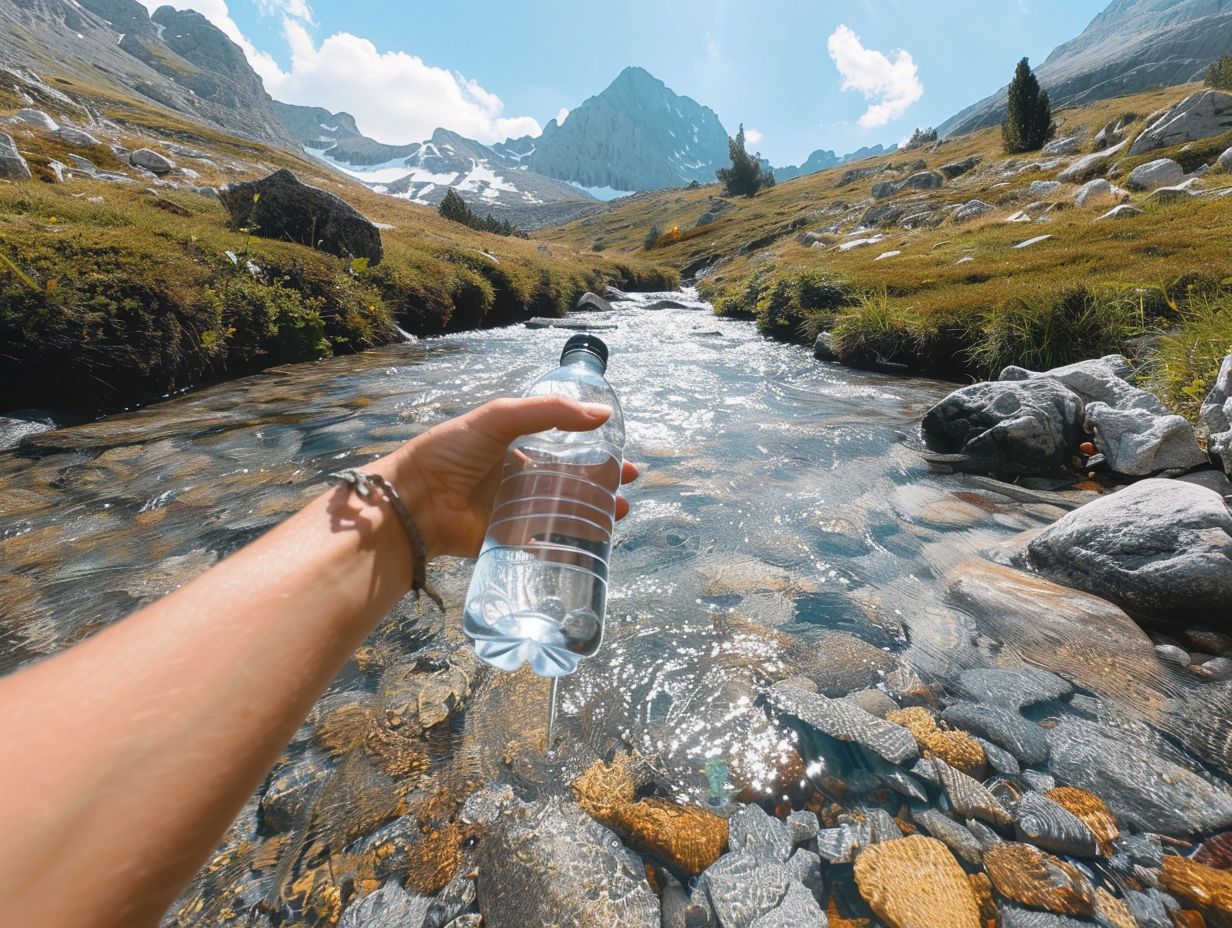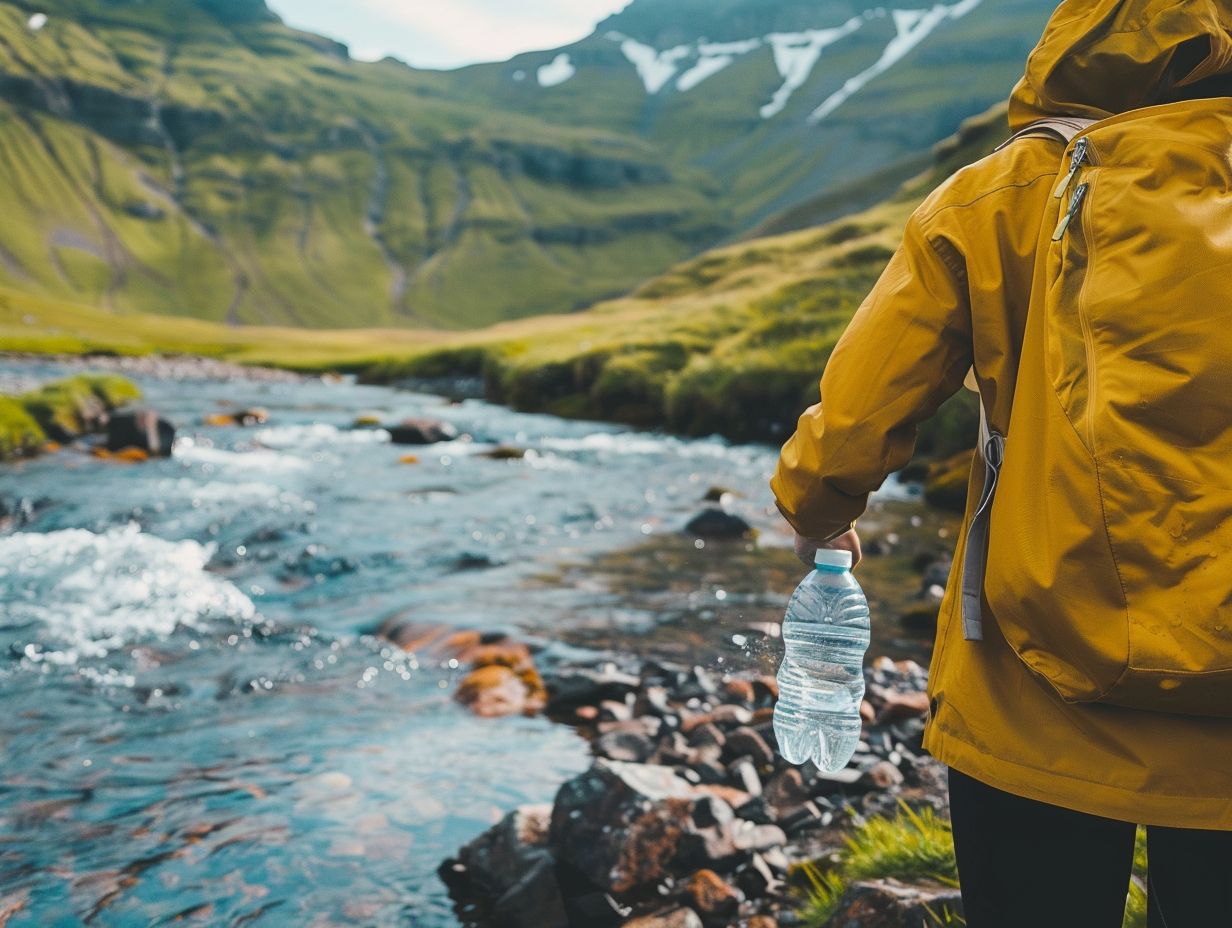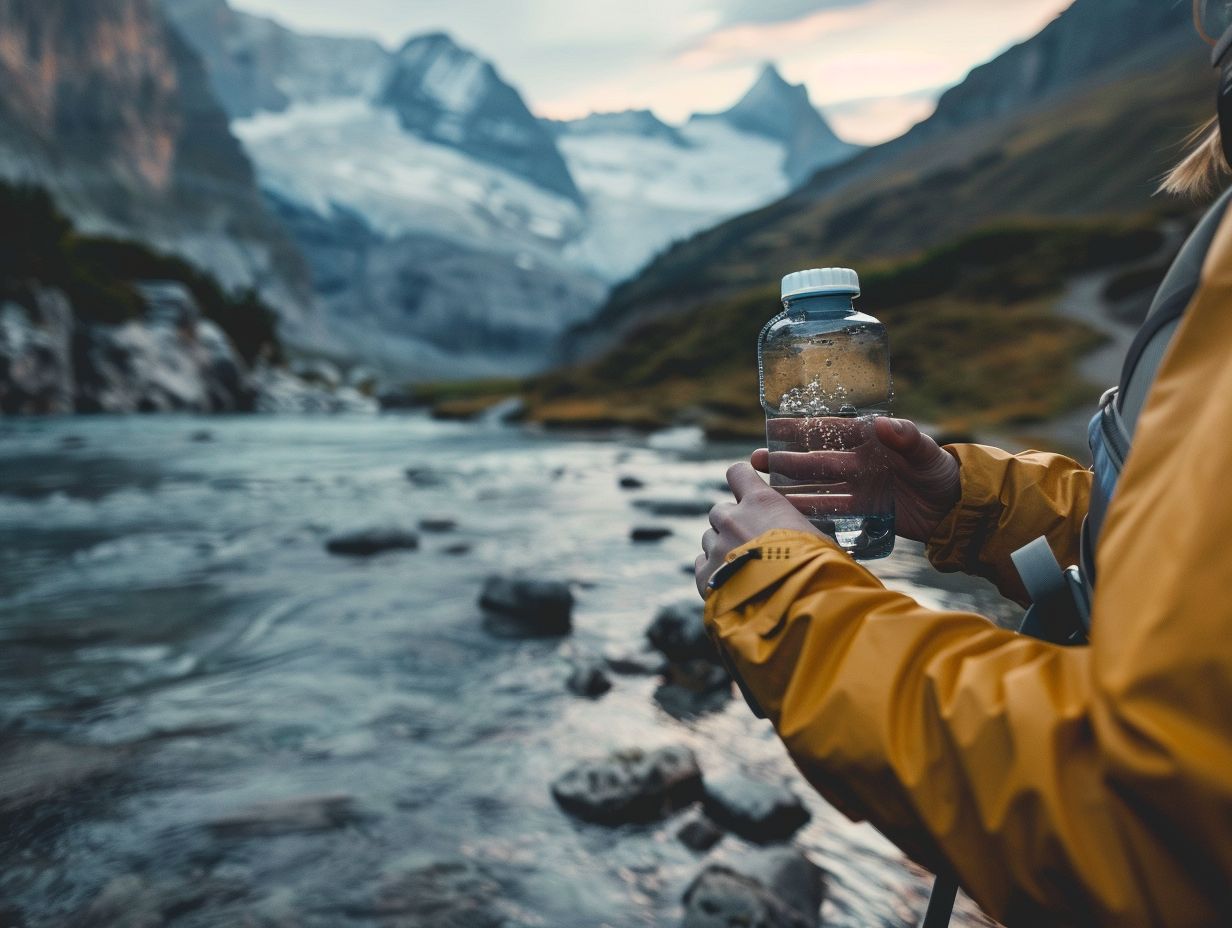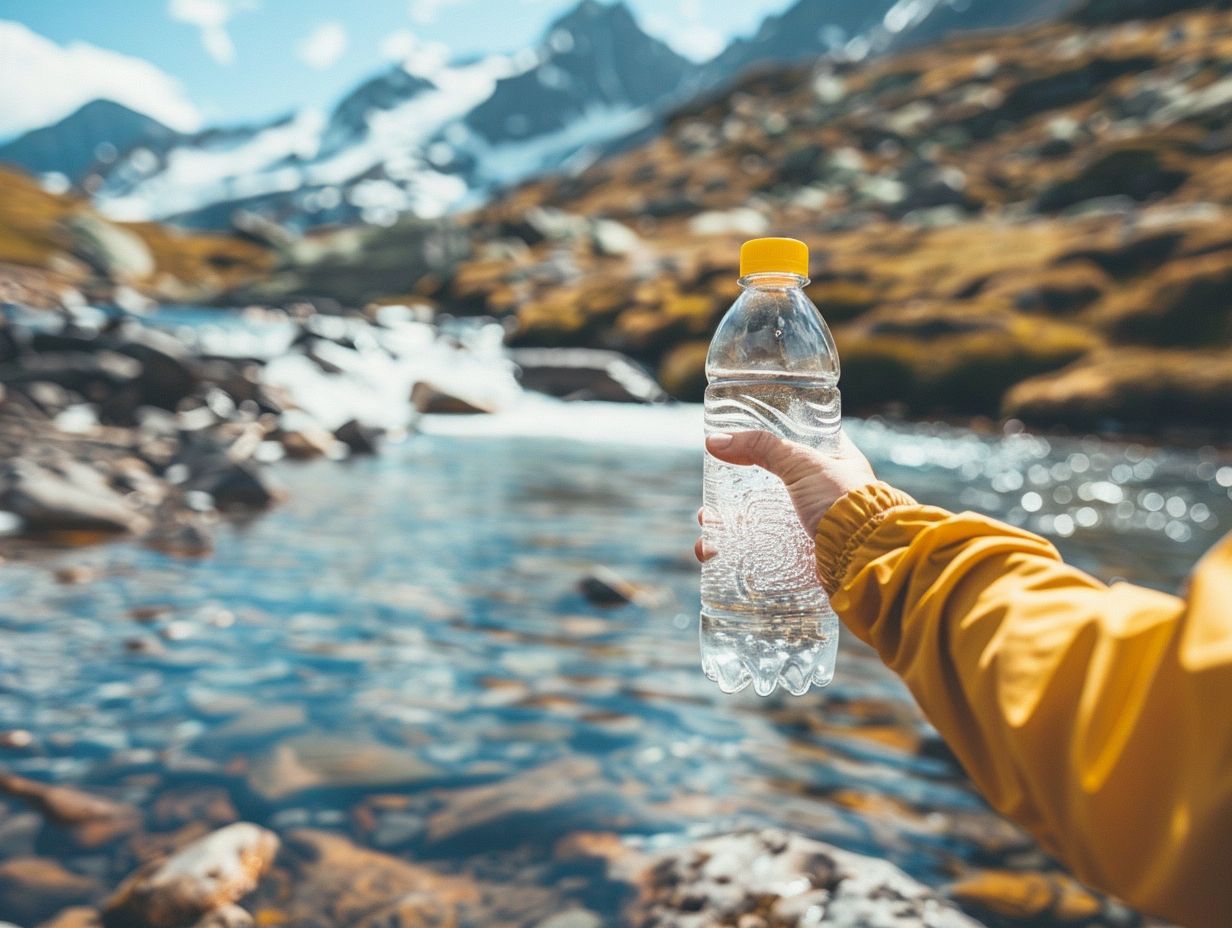When heading out for a camping trip, one of the most critical factors to consider is how to guarantee access to safe drinking water throughout your outdoor excursion.
This article offers 15 essential tips that will assist you in maintaining proper hydration and well-being while relishing the beauty of nature. Let’s delve into these practical and straightforward recommendations to ensure that you can access clean and safe drinking water on your upcoming camping expedition.
Key Takeaways:

- Always bring enough water for your camping trip to ensure you have a safe and sufficient water supply.
- Invest in a reliable water filter to remove any potential contaminants from natural water sources.
- Boiling water before drinking is a simple and effective way to purify it and make it safe for consumption.
1. Bring Enough Water for Your Trip
When embarking on your camping or backpacking adventure, it is essential to ensure you bring an ample supply of water to stay hydrated throughout your journey.
Dehydration can not only be uncomfortable but also dangerous, particularly in outdoor settings where access to clean water may be limited. Proper hydration is crucial for maintaining energy levels, preventing heat-related illnesses, and ensuring overall well-being during your outdoor excursions.
It is imperative to plan ahead and calculate how much water you will need based on factors such as the duration of your trip, the intensity of physical activity involved, and the climate you will be navigating through. By being mindful of your water requirements and packing accordingly, you can optimise your outdoor experience and maintain safety and health throughout your journey.
2. Use a Reliable Water Filter
When selecting a reliable water filter for outdoor activities like camping and backpacking, it is essential to prioritize the removal of harmful pathogens and ensure the safety of your drinking water. Various types of water filters are available in the market, each having distinct features and capabilities.
Common options include straw filters, pump filters, gravity filters, and UV purifiers. While these filters are generally effective at eliminating bacteria and protozoa, not all are equipped to deal with viruses.
It is crucial to thoroughly examine the specifications of a water filter to verify its compatibility with your water purification needs.
Effective maintenance of your water filter is crucial to maintain its performance and durability. Regular cleaning and replacement of filter cartridges are essential steps to prevent blockages and preserve the efficiency of the filter.
3. Boil Water Before Drinking
Boiling water before consumption is a widely recognised method for eliminating pathogens and ensuring the safety of drinking water, especially in situations where clean water sources are limited or unavailable.
When you bring the water to a rolling boil, the high temperature effectively eradicates harmful bacteria, viruses, and parasites that may be present in the water.
It is advised to maintain the boiling process for a minimum of one minute, or up to three minutes at elevated altitudes, to guarantee thorough elimination of all potential contaminants.
By disrupting the cellular structure of microorganisms through heat, boiling serves to neutralise waterborne pathogens, thereby rendering the water safe for consumption and diminishing the likelihood of waterborne diseases.
4. Avoid Drinking from Natural Sources
It is recommended that you refrain from consuming water directly from natural sources such as lakes, rivers, and streams whilst camping or backpacking due to the potential presence of waterborne pathogens.
Untreated water from these sources may contain harmful bacteria, parasites, and viruses that can result in gastrointestinal illnesses like diarrhoea, vomiting, and stomach cramps. To mitigate these risks, campers can consider utilising water filtration systems or chemical disinfection methods to ensure the safety of their drinking water.
Filtration options vary from portable water filters to pump filters, whilst disinfection methods include employing chlorine tablets or ultraviolet light devices to eliminate any harmful pathogens present in the water.
Prioritising water safety is crucial for maintaining a healthy camping experience.
5. Store Water in Clean Containers

Properly storing water in clean and sanitised containers is essential for preventing contamination and preserving the quality of drinking water during outdoor excursions.
When selecting containers, it is advisable to choose food-grade vessels specifically designed for water storage to reduce the risk of chemical leaching or bacterial growth.
Regularly cleaning and sanitising these containers is equally important to prevent the accumulation of germs and algae. Designating separate containers for water storage, distinct from those used for other liquids or food items, helps avoid cross-contamination.
By following simple cleaning procedures, such as washing with hot, soapy water and thorough rinsing, you can effectively maintain the hygiene of your water storage containers and ensure safe consumption while preserving the taste and freshness of the water.
6. Bring Water Purification Tablets
Including water purification tablets in your camping or backpacking essentials can provide you with a convenient and effective method to disinfect water and safeguard against waterborne illnesses. These tablets work by releasing chemicals that kill or neutralise harmful bacteria, viruses, and protozoa present in untreated water.
The active ingredients typically include chlorine dioxide or iodine, which are known for their efficacy in water treatment. The portability of water purification tablets makes them a practical solution for hikers, travellers, and emergency preparedness kits, as they are lightweight and easy to carry.
Simply dropping a tablet into a container of water allows for easy and quick purification, ensuring safe drinking water wherever you are.
7. Use a UV Water Purifier
Utilising a UV water purifier provides you with a reliable and speedy method for purifying water by deactivating harmful pathogens using ultraviolet light technology, ensuring the safety of drinking water in outdoor environments.
These purifiers are both portable and user-friendly, making them well-suited for activities like camping, hiking, or travelling.
A key advantage of UV purification is that it does not affect the taste or smell of the water, unlike certain chemical treatments. It is important to bear in mind that UV purifiers rely on electricity, which may present a challenge in remote locations.
When planning for prolonged journeys, it is essential to consider the battery life of the purifier to guarantee uninterrupted access to clean water.
8. Be Aware of Local Water Warnings
It is essential to stay informed about any local water warnings or advisories in your camping or hiking area to prevent potential exposure to contaminated water sources and reduce health risks.
You can access local water quality alerts through various sources, including the Environmental Protection Agency (EPA), your state or local health department, or specific websites dedicated to water quality.
Common reasons for warnings may include bacterial contamination, chemical spills, or natural disasters impacting water sources. When warnings are issued, proactive steps to consider involve boiling water before use, utilising water purification tablets or filters, or selecting alternative water sources such as bottled water for drinking and cooking purposes.
9. Use a Collapsible Water Container
Opting for a collapsible water container can provide you with a space-saving and lightweight solution to transport and store water during outdoor activities such as camping or backpacking.
These practical containers not only offer convenience but also contribute to environmental sustainability by reducing the usage of single-use plastic bottles.
Their versatility allows them to easily fit into rucksacks or vehicles, making them well-suited for hiking excursions or inclusion in emergency preparedness kits. Maintaining collapsible water containers is relatively straightforward – a simple rinse with soap and water is usually adequate.
These containers are compatible with various water treatment methods such as purification tablets or filters, ensuring access to safe drinking water regardless of where your adventures lead you.
10. Bring a Portable Water Pump

Including a portable water pump in your kit can provide you with a handy way to access and filter water from natural sources, ensuring a fresh water supply for hydration during your outdoor adventures.
When you have a portable water pump to hand, you eliminate the need to rely solely on prepacked bottled water, reducing both waste and overall costs.
There are various types of portable water pumps available, such as hand-operated pumps, electric pumps, and battery-powered pumps, each offering unique benefits depending on your specific requirements.
When using a portable water pump for filtering, be sure to follow manufacturer guidelines for optimal performance.
Regular maintenance, proper cleaning, and replacing filters as recommended are essential steps to ensure effective water purification and a dependable water source while exploring the great outdoors.
11. Use Water Disinfectant Drops
When utilising water disinfectant drops, you are employing a straightforward and efficient approach to water treatment. By neutralising pathogens, these drops render water safe for consumption, adding an extra layer of protection especially useful during outdoor excursions.
The significance of these drops lies in their ability to eradicate harmful bacteria, viruses, and other microorganisms that pose a risk of waterborne diseases. Adherence to the recommended dosage instructions is crucial when using disinfectant drops to ensure effective disinfection.
It is important to note that different products may contain varying concentrations, necessitating careful reading of the label for precise dosage guidance. These drops are typically compatible with a range of water sources, including rivers, lakes, and even tap water, making them adaptable to diverse scenarios.
12. Bring a Water Testing Kit
Carrying a water testing kit allows you to evaluate the quality of water from different sources, enabling you to confirm its suitability for drinking purposes and implement necessary water treatment procedures while outdoors. Water testing is vital not only for outdoor activities such as camping or hiking but also for daily use.
A standard water testing kit includes equipment for measuring pH levels, chlorine content, hardness, and the presence of bacteria. By conducting these assessments, you can detect potential contaminants in the water, like bacteria or chemicals, that could pose health hazards if ingested.
Proper interpretation of the results obtained from water testing is essential for making informed decisions on whether the water is safe for consumption or requires treatment before usage.
13. Consider Bringing Bottled Water
When you’re planning for your outdoor adventure, it’s important to consider the convenience and reliability of bottled water. Opting to bring pre-packaged bottled water can ensure you have a readily available and safe drinking water supply.
It’s crucial for you to carefully evaluate the advantages and disadvantages of relying on bottled water. One of the key benefits is the convenience it offers, especially when you’re on the go or enjoying outdoor activities. Bottled water is easily accessible and typically purified, which makes it a safe choice for staying hydrated.
However, it’s important to acknowledge the environmental impact of using single-use plastic bottles, which contributes to pollution. To address this issue, you may want to consider using reusable water bottles or investing in larger containers of water for refills to help minimise waste.
Proper storage of bottled water is essential to preserve water quality. Make sure to store the bottles away from direct sunlight and chemicals, and keep them in a cool, dry location to prevent contaminants from compromising the water’s integrity.
Be Mindful of Water Usage
Practising water conservation and mindfulness about water usage is essential during outdoor activities to ensure an adequate supply for hydration, cooking, and cleaning while minimising the environmental impact.
An effective strategy for reducing water waste in wilderness settings is to collect and reuse rainwater whenever possible. Setting up a simple rain catchment system using a tarp or waterproof container can allow for the capture of rainwater for various tasks.
Being mindful of not letting taps run unnecessarily and utilising water-efficient cooking and cleaning methods can also significantly contribute to conserving water while enjoying the outdoors.
Pack Out What You Pack In

Adhering to the principle of ‘pack out what you pack in‘ is critical for preserving wilderness areas and water sources. This practice ensures minimal impact on the environment and helps maintain the natural beauty of the outdoors.
This principle is in line with the core concept of Leave No Trace, which promotes responsible outdoor ethics to minimise human impact on the environment. By adhering to Leave No Trace principles, individuals can contribute to protecting ecosystems, wildlife habitats, and sensitive landscapes.
Responsible waste management is essential during outdoor activities to prevent pollution, contamination, and disruption of natural ecosystems. Proper waste disposal, recycling when feasible, and leaving natural spaces undisturbed are vital components of this practice.
Specific actions to follow include carrying out all rubbish, burying human waste properly, avoiding damage to vegetation, and staying on marked trails to minimise erosion. Following these guidelines not only benefits the environment but also ensures that outdoor spaces remain pristine for future generations to enjoy.
Frequently Asked Questions
What are some essential tips for safe drinking water while camping?
1. Bring a reliable water filtration or purification system to treat any water from natural sources.
2. Always boil water for at least 1 minute before consuming, if a filtration system is not available.
3. Avoid drinking from stagnant or visibly contaminated water sources.
4. Use clean, designated water containers to store and transport water.
5. Keep your hands and any other equipment used for water collection and treatment clean.
6. Monitor any potential waterborne illness symptoms and seek medical attention if necessary.
What are the benefits of using a water filtration or purification system while camping?
A water filtration or purification system can remove harmful bacteria, viruses, and parasites from natural water sources, making it safe to drink. It also reduces the risk of contracting waterborne illnesses, which can be particularly dangerous while camping and away from medical facilities.
Is it safe to drink water directly from a lake or river while camping?
No, it is not safe to drink water directly from a lake or river without treating it first. These water sources can contain harmful bacteria, parasites, and viruses that can cause serious illnesses. Always use a water filtration or purification system or boil the water before consuming it.
What should I do if I run out of clean drinking water while camping?
If you run out of clean drinking water while camping, you can collect and treat water from natural sources. If that is not an option, you can also use water purification tablets or chemical drops, which are lightweight and easy to carry. Alternatively, you can melt snow or boil water from a nearby stream.
How can I ensure the water containers I use for camping are clean and safe?
Before using any water containers for camping, make sure they are clean and sanitised. You can do this by thoroughly washing them with soap and water and then rinsing them with a solution of water and bleach. Let them air dry before storing them in a clean, dry place.
Should I be concerned about waterborne illnesses while camping in the wilderness?
Yes, it is essential to be aware of potential waterborne illnesses while camping in the wilderness. These can include illnesses such as giardia, cryptosporidiosis, and E. coli. It is crucial to follow proper water safety tips and monitor any symptoms of illness while camping to ensure your health and safety.



